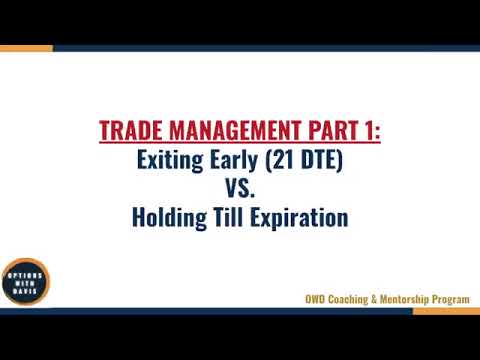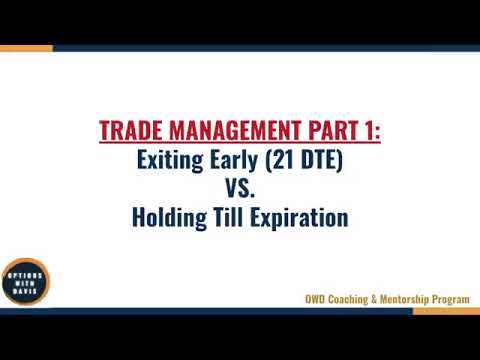In the first part of the “2-5 Trade Management Part 1 DTE vs Expiration” video, we’ll be discussing the benefits and recommendations of exiting a trade at 21 DTE (days to expiration) for better trade management. Research conducted by the tastytrade team has shown that exiting at 21 DTE can help reduce risk and improve performance. While holding trades until expiration may result in higher profits, it also comes with higher risk. Exiting at 21 DTE helps minimize the probability of reaching maximum loss, manage risk, reduce losses, and avoid early assignment on in-the-money options.
Now, let’s take a closer look at an example like the iron condor. If you hold it all the way to expiration, your profit line appears higher. However, exiting at 21 DTE seems to limit the profit zone. So, which one is better? Many people assume it’s best to hold until expiration, but research suggests otherwise. Exiting at 21 DTE has shown to be a more favorable choice, managing risk better and improving overall performance.
Overview
Exiting a trade at 21 DTE (days to expiration) is recommended for better trade management. Research shows that exiting at 21 DTE reduces risk and improves performance. Holding trades until expiration may result in higher profits, but also higher risk. Exiting at 21 DTE minimizes the probability of reaching maximum loss, manages risk and reduces losses compared to holding until expiration, and helps avoid early assignment on in-the-money options.
Advantages of Exiting at 21 DTE
By exiting at 21 DTE, you can minimize the probability of reaching maximum loss. Options trading involves inherent risks, and holding trades until expiration can increase the likelihood of losses. Exiting at 21 DTE allows you to manage your risk and reduce potential losses.
Additionally, exiting at 21 DTE helps avoid early assignment on in-the-money options. When an option is in-the-money, there is a higher risk of early assignment, which can lead to unexpected losses. By exiting at 21 DTE, you can mitigate this risk and maintain control over your trades.
Exceptions to Exiting at 21 DTE
While exiting at 21 DTE is generally beneficial, there are exceptions to this rule. One such exception applies to the put ratio spread on cash settled indices. In this particular case, it may be more advantageous to hold the trade until expiration, as the dynamics of cash settled indices can differ from other options trades.

Factors to Consider when Exiting at 21 DTE
When deciding whether to exit at 21 DTE, several factors should be taken into consideration. One important factor is volatility and market conditions. High volatility may increase the potential for profits, but it also comes with higher risks. Evaluating market conditions and considering volatility can help you make informed decisions about exiting your trades.
Profit targets and risk tolerance are also crucial factors to consider. Setting realistic profit targets allows you to maintain a balanced approach to trading. Understanding your risk tolerance helps you determine how much exposure you are comfortable with and when it may be appropriate to exit a trade.
Your trading strategies and objectives should also guide your decision to exit at 21 DTE. Different strategies may require different timeframes for exit. Consider whether your strategy aligns with the benefits of exiting at 21 DTE or if an alternative exit strategy may be more suitable.
Alternative Exit Strategies
Although exiting at 21 DTE is recommended in many cases, it is not the only approach to trade management. Holding trades until expiration is an alternative strategy that may result in higher profits. However, it is important to recognize the increased risk associated with this approach.
Adjusting positions based on the market trend is another alternative exit strategy. By monitoring market conditions and trends, you can make adjustments to your trades to capitalize on potential opportunities or manage risks more effectively.
Implementing stop-loss orders is another way to manage your trades. A stop-loss order automatically exits a trade when it reaches a predetermined price, allowing you to limit potential losses.
Case Studies on Exiting at 21 DTE
Analyzing historical trade data can provide valuable insights into the benefits of exiting at 21 DTE. Comparing different exit strategies can give you a better understanding of their impact on overall trade performance. By reviewing case studies and real-life examples, you can see how exiting at 21 DTE has been successful and assess its potential benefits for your own trades.
Tips for Effective Trade Management
To effectively manage your trades, it is important to regularly monitor your positions. By staying updated on market conditions and any changes in your trades, you can make informed decisions about when to exit.
Setting realistic profit targets is also essential for successful trade management. Striving for overly aggressive targets may expose you to unnecessary risks. By setting achievable profit targets, you can maintain a more sustainable approach to trading.
Utilizing trailing stops can also enhance your trade management. Trailing stops automatically adjust to the market’s movement, allowing you to lock in profits or limit losses without constant manual adjustments.
Analyzing and learning from past trades is another valuable strategy for trade management. By reviewing your previous trades, you can identify patterns, understand what works and what doesn’t, and make adjustments to improve your future trades.
Risk Management Techniques
Effective trade management involves implementing risk management techniques. Position sizing and portfolio diversification help you spread your risk across multiple trades and assets, reducing the impact of any single trade.
Applying appropriate risk-to-reward ratios is another essential risk management technique. By assessing the potential risk and reward of each trade, you can ensure that your potential gains outweigh your potential losses.
Utilizing risk management tools and software can also enhance your trade management. These tools provide insights into risk metrics, volatility, and other factors that impact trade performance, assisting you in making more informed decisions.
Developing a Trade Management Plan
To optimize your trade management, it is recommended to develop a comprehensive plan. This includes identifying your trade objectives and goals, such as profit targets and risk tolerance. By setting clear criteria for exit based on DTE, you can ensure consistent and disciplined trade management.
Implementing contingency plans for market changes is also crucial. Markets are dynamic and can change rapidly, so having backup plans in place allows you to adapt and make informed decisions even under unpredictable circumstances.
Conclusion
Exiting at 21 DTE offers numerous benefits for trade management. By minimizing the probability of reaching maximum loss, managing risk and reducing losses, and avoiding early assignment on in-the-money options, exiting at 21 DTE helps you maintain control and improve your overall trade performance.
While there are exceptions to this rule, such as the put ratio spread on cash settled indices, the general research supports the advantages of exiting at 21 DTE. By considering factors like volatility, profit targets, trading strategies, and risk tolerance, you can make informed decisions about when to exit your trades.
Remember, effective trade management requires regular monitoring, setting realistic profit targets, utilizing trailing stops, and analyzing past trades. By implementing risk management techniques, such as position sizing and portfolio diversification, and developing a trade management plan, you can optimize your trading success.
